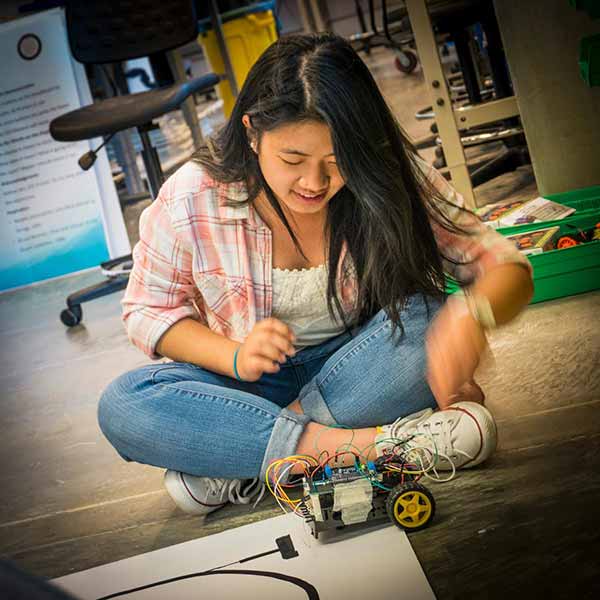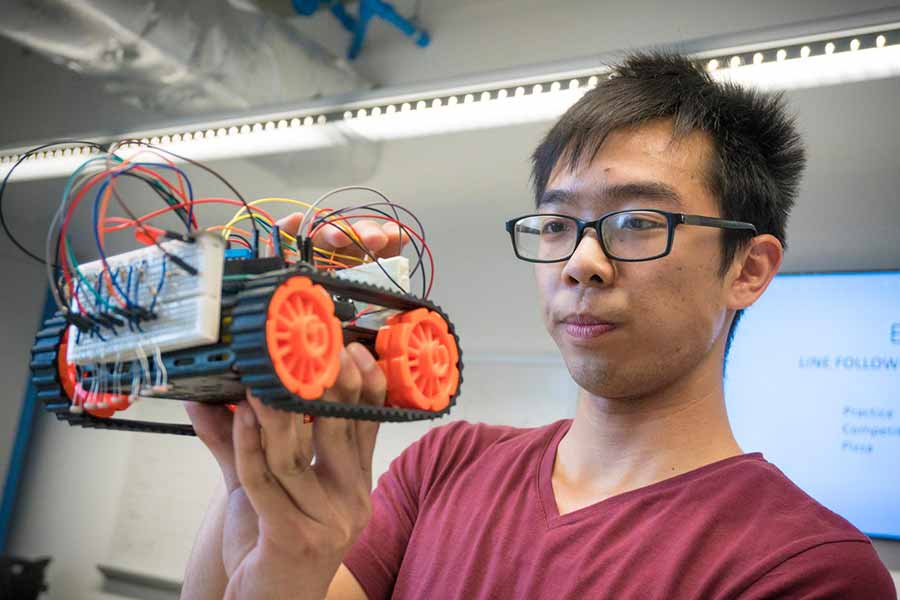
Electrical Engineering Undergrads Build and Race Robots
Published Date
By:
- Deborah Osae-Oppong
Share This:
Article Content

A student watches her robot run the program to calibrate black and white.
The EnVision Arts and Engineering Maker Studio at UC San Diego teemed with excitement on the day of the final in an electrical engineering class called Making, Breaking and Hacking Stuff. Instead of a typical test, the class culminated in a cumulative final project – teams of two or three students used the knowledge and some of the parts they had acquired during the class’s previous projects to build a line-following robot. The teams competed to see who programmed their robot to follow a line most closely, and at the fastest speed.
This final project required the students to program a robot to recognize the difference between black and white so that it could follow a black line drawn on white paper. Once the students succeeded at building a robot that is capable of automatically following a line, some incorporated other features from their previous projects while other teams tried new sensors.
The robots competed in time trials on three different tracks – an increasingly difficult squiggle, a circle, and a line with a small detour. They also competed in a drag race.
During the drag race, one team’s robot followed a line, but went too fast and spun off the track.
The winning team’s robot stayed on the track the whole time, and got to the end faster than the others.

Eric Ho double checks his robot to make sure it is working properly for the next time trial.
“We code the microcontroller on our robot to read a voltage value off attached photoresistors,” said electrical engineering major (?) Eric Ho, a member of the winning team. “The value changes when light reflected from the floor back to the sensor changes, letting the robot know where that black line is. We all incorporated these and LED lights, which were part of our first project in the course. In order to increase or decrease the speed and the turn rate necessary to follow a line we also hooked up knobs that let us alter the inputs to our control algorithm so our robot could run autonomously.”
According to Ho, their team won because they were able to determine the best input values for the speed and the three inputs for their control algorithm, adjusting through trial and error.
“Building the robot and seeing their code and the theory in action is a great way to end the course and start them off on their four year electrical and computer engineering journey,” said Karcher Morris, an electrical engineering graduate student at the Jacobs School and TA for the course.
Both the class and the Envision Maker Studio are key components of the UC San Diego Jacobs School of Engineering’s Experience Engineering Initiative. This school-wide project aims to give every engineering and computer science undergraduate student a hands-on or experiential engineering course or lab each and every year – starting freshman year. (Read about other Experience Engineering classes at the Jacobs School.)
The maker studio opened to students in January 2016 with more than 25 sections of four different hands-on laboratory classes, ECE5 being one of them. (Read about it here.)
Share This:
You May Also Like
Stay in the Know
Keep up with all the latest from UC San Diego. Subscribe to the newsletter today.


